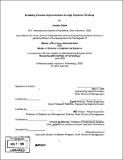| dc.contributor.advisor | Daniel Whitney and Roy Welsch. | en_US |
| dc.contributor.author | Dolak, Jessica | en_US |
| dc.contributor.other | Leaders for Manufacturing Program. | en_US |
| dc.date.accessioned | 2007-04-03T17:14:45Z | |
| dc.date.available | 2007-04-03T17:14:45Z | |
| dc.date.copyright | 2006 | en_US |
| dc.date.issued | 2006 | en_US |
| dc.identifier.uri | http://hdl.handle.net/1721.1/37128 | |
| dc.description | Thesis (M.B.A.)--Massachusetts Institute of Technology, Sloan School of Management; and, (S.M.)--Massachusetts Institute of Technology, Engineering Systems Division; in conjunction with the Leaders for Manufacturing Program at MIT, 2006. | en_US |
| dc.description | Includes bibliographical references (p. 78-79). | en_US |
| dc.description.abstract | Manufacturing organizations around the world strive to improve processes with varying degrees of realization. There is no right way or latest and greatest process that can guarantee success, therefore the approach, and not necessarily the process, is critical. Since every process improvement project is different, using the systems thinking approach decreases the risk of failure as the implementer(s) is/are more aware of critical items on the fringe which might otherwise be neglected. Process metrics are vital for many reasons including motivating employees, determining the level of need for process improvement, and evaluating the outcome of a process improvement project. When evaluating whether a project should be pursued, the expected results on the subsystem and other subsystems should be estimated and tied to the highest level metric, which ultimately should equate to bottom line impact. This evaluation technique ensures a positive impact on the entire system, rather than producing only a subsystem optimum. A subsystem metric indicates a project's success through the use of a hypothesis test. This usage requires that the subsystem metric, which will be used to measure a process improvement, must be stable before initiating the project. | en_US |
| dc.description.abstract | (cont.) The individual, team, and organization all play a vital role in a company embracing systems thinking. Individuals and teams need to keep an open mind to issues outside the focus department and accept and encourage involvement of cross-functional representatives on process improvement teams. An organization where systems thinking is integral becomes a learning organization and has a higher percentage of successful projects through a systematic evaluation and approach to projects. To maintain the systems thinking culture, an organization as a whole must encourage the hiring of individuals with varied experiences and who believe in systems thinking. | en_US |
| dc.description.statementofresponsibility | by Jessica Dolak. | en_US |
| dc.format.extent | 79 p. | en_US |
| dc.language.iso | eng | en_US |
| dc.publisher | Massachusetts Institute of Technology | en_US |
| dc.rights | M.I.T. theses are protected by copyright. They may be viewed from this source for any purpose, but reproduction or distribution in any format is prohibited without written permission. See provided URL for inquiries about permission. | en_US |
| dc.rights.uri | http://dspace.mit.edu/handle/1721.1/7582 | |
| dc.subject | Sloan School of Management. | en_US |
| dc.subject | Engineering Systems Division. | en_US |
| dc.subject | Leaders for Manufacturing Program. | en_US |
| dc.title | Enabling process improvements through systems thinking | en_US |
| dc.type | Thesis | en_US |
| dc.description.degree | S.M. | en_US |
| dc.description.degree | M.B.A. | en_US |
| dc.contributor.department | Leaders for Manufacturing Program at MIT | en_US |
| dc.contributor.department | Massachusetts Institute of Technology. Engineering Systems Division | |
| dc.contributor.department | Sloan School of Management | |
| dc.identifier.oclc | 85776583 | en_US |
